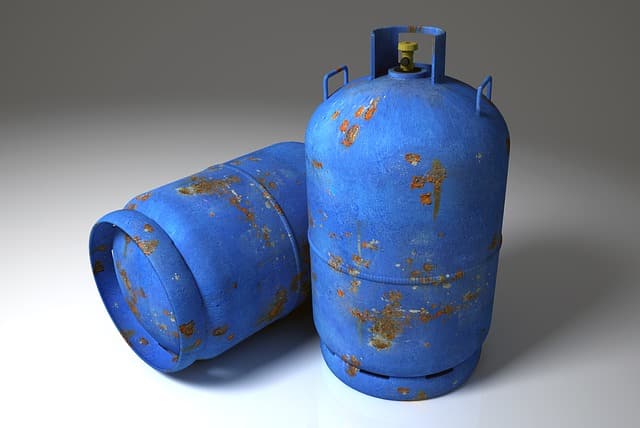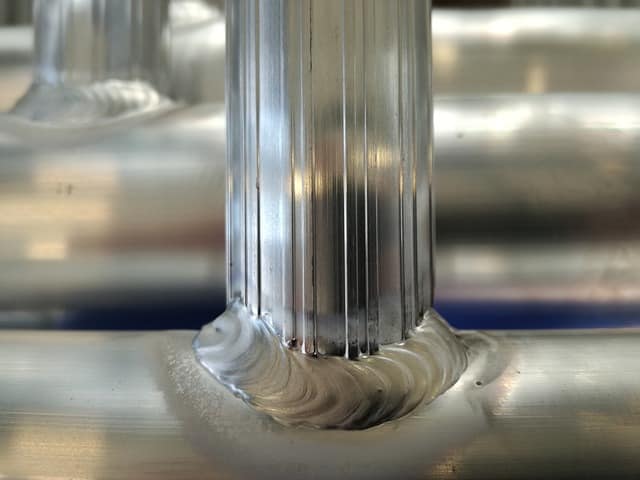
When it comes to marrying metal, there is no universal type of welding gas that can be used for kind of metals. Generally, the welders decided on the type of gas to be used based on the material type to be welded. The welder will consider whether the material is ferrous or not, magnetic or not and finally for what purpose the metal is going to be used for.
There is only two major types of welding methods that use gas in the process and they are:
Gas Metal Arc Welding –(GMAW or MIG Welding)
In this type of welding, a welding wire (electrode) is fed right above the welding buddle and an arc produced by current melts the welding wire and melts the pieces together. The shielding gas is used to protect the base metal or the welding bead from getting contaminated by the surrounding air which otherwise would react with the molten metal.
Gas Tungsten Arc welding – (GTAW or TIG welding)
In this process, a tungsten electrode is used along with shielding gas to heat the filler metal that is placed closely on top of the base metals and an arc created due to the power supply welds the joints, while the gas protects the weld.
Gases Used for Gas Metal Arc Welding Welding
Contents
Gas is the main component in MIG (Metal Inert Gas) welding as these inert gases won’t react with the welding bead, where non-inert gases like oxygen can react with outside air and cause the bead to become highly porosity. That is the reason, shielding gas is extremely important during the process of MIG welding as these inert gases provide a shield over the metal and prevent any kind of weld defects like pinholes and porosity.
Sometimes, Oxygen and Carbon Di-Oxide is added to the shielding gas mixture, this doesn’t become a pure inert gas welding process as both Oxygen and CO2 are non-inert gases. The type of gas used in MIG welding also determines the following:
- How deep the weld is penetrated into the metal
- The characteristics and the nature of the arc produced
- And finally, the mechanical properties of the weld
What gas should I use for MIG welding?
When you are not sure about which type of gas to be used for your welding job, it is always a good idea to take some inputs from the personnel in a welding supply store as they can help you choose the perfect type of gas based on your welding requirements. Nowadays, most of the welding machines and welding wire manufacturers also provide you with detailed user manuals about the type of gas to be used along with the voltage setting and gas feed rate, etc. In most cases, the user manual will recommend a few choices that will yield better results (at least well-established manufacturers do).
For gas flow rate settings you need a gas regulator. If you do not have one, I would recommend this one from Amazon. It is cheap and works like a charm.
The best gas for MIG welding and the types of welding gases used are namely:
Welding Gas for Carbon Steel
When it comes to the gases used in normal welding for Carbon steel, many welders used the C25 mixture that consists of CO2-25% and Argon gas – 75%, because CO2 cannot be used separately in some cases as it creates a deeper penetration along with lots of smoke and even may cause a rough-looking weld. And for that matter, the reason Argon gas is used mainly for carbon steel welding. Some welders also recommend many other types of mixtures but if you are not sure, better seek the help of the user manual or the inscription made on the welding machine.
In most cases, as a hobby welder planning to weld only carbon steel, it is perfectly fine to use Co2, yes it is a bit more difficult to weld very thin sheet metal and it produces a bit more spatter, but it is a lot cheaper.
Welding Gas for Stainless Steel
While choosing the Shielding gas for MIG welding stainless steel, welders usually prefer a mixture consisting of Argon – 98% and CO2 – 2% while some prefer to use the gas mixture of Helium -90%, Argon – 7% and CO2 – 2%. Some welding stores even come up with their own mixture that can largely help in improving the weld quality to a great extent.
Besides the right gas, you also need quality welding wire for the job. This one is my favorite: https://amzn.to/2P0o8D7
MIG Gas for Aluminum

For welding aluminum, Argon gas is mainly used materials as it is very sensitive to contamination and it pure argon helps to produce better results while marrying aluminum, but it is also important to remember if the aluminum material is more than half an inch thick, it might be a good idea to have some Helium (25%) added to the mix to produce optimal results.
For aluminum, I prefer this wire from Amazon.
Gas for Copper Alloy
For Copper alloy welding, a mixture of Argon – 75% and Helium – 25% is mainly used as these gases work well in welding copper alloy materials.
How to Choose the Right Gas
When it comes to MIG welding, the type of gas needed is primarily based on the type of application and the welding goals you need to accomplish. You need to take into account the cost of the gas, and properties of the base material along with the weld transfer method. before selecting a shielding gas for MIG welding.
The 4 common gases used for MIG welding are generally Argon, Helium, and Carbon Dioxide since any kind of mixture normally revolves around these 4 gases. And in most cases, only the percentages differ based on the material to be welded.
Carbon Dioxide is one of the most commonly used reactive gas used in MIG welding as it can be used in its purest form without needing to add any inert gases. It is also one of the cheapest shielding gasses available in the market and thus makes it one of the most popular choices among many welders. When you use carbon dioxide in its purest form, you can get deeper penetration which can be largely helpful when you are welding materials that are thicker, but CO2 gas produces a more unstable arc and it can produce more spatter.
Most companies who want to produce the best weld quality possible along with a less time spent for cleanup after the welding process, always will go for a gas mixture that includes Argon and CO2 in a mixture of 75% -25% as it provides the welders to get a more stable arc and the puddle control is also great. And you do not need to worry about the splatter as much unlike when using pure CO2 alone.
Using this kind of mixture also allows welders to utilize the spray transfer process that can help in producing higher productivity along with much cleaner and good-looking welds.
On the other hand for welding metals like aluminum, magnesium or titanium that are non-ferrous, I would advise you to go with using 100% Argon gas.
Similar to Argon, Helium can be used for MIG welding of non-ferrous metals and also for welding stainless steel. The reason is that Helium creates a deep and wide penetration that can be largely helpful in welding thicker materials. And when a mixture of Helium gas is used, it creates an arc that is a
Characteristics of Welding Gasses
In GMAW welding, different types of shielding gases can produce various types of characteristics including:
- Argon gas can produce a shallow but wide penetration profile and the arc is also smooth and comes with a lot of fluidity
- Helium produces a very hot arc and the penetration is mild along with a fluidic arc to produce greater weld productivity
- Carbon dioxide creates both a deep and very narrow penetration profile with a stiff arc that can be very helpful in out-of-position welding
- Argon or Helium, when mixed
with CO2, can produce deeper penetration and it also stiffens the arc to a great extent which finds excellent use in out of position welding - Helium, when added to any
kind of gas mixture, makes the arc a lot hotter - Argon or Helium, when mixed
with oxygen in a smaller amount, can produce deeper penetration and stiffen the arc
Gas Affects Arc Transfer Type
Most people don’t mention it but in GMAW welding, shielding gases can also affect the weld transfer and for that reason
- In
Short Circuit transfer either pure Carbon Dioxide or a high percentage of Carbon Dioxide is required. - When you are using a mixture of more than 75% of Argon in the mixture, then better to go for globular transfer
- Spray transfer method is generally used while having a mixture with 75% or more Argon gas
Conclusion
Overall, for a hobby welder this post might have made things even more complicated when it comes to types of welding gases, but to answer in short what gas is used for MIG welding, I would say that in most cases it is perfectly okay to go with pure CO2 only. The reason is that it is not that difficult to weld regular steel with it and it is much cheaper compared to
What gas are you using? Drop a comment below!
